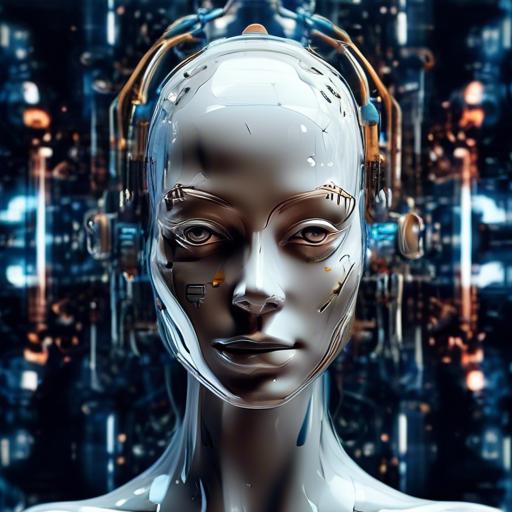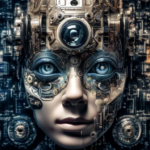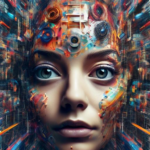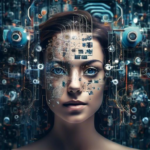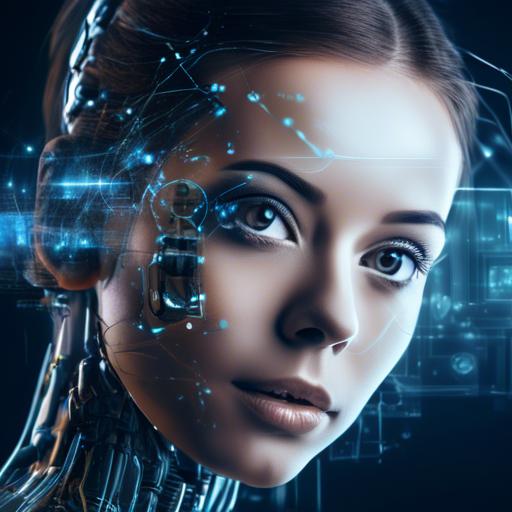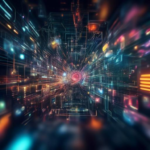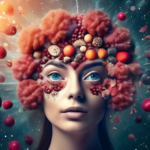In the realm of modern technology, where innovation sprouts like wildflowers after a spring rain, few concepts loom larger or possess greater potential than Big Data and Artificial Intelligence (AI). Imagine these two powerful forces intertwining, manifesting through the vivid canvas of image generation. It is a symbiotic dance; a duet that shapes the very fabric of our digital landscapes. This article embarks on a journey into this fascinating confluence—where billions of data points become the maestro, orchestrating pixels into breathtaking art. Let’s delve into the impressive role Big Data plays in AI image generation, illuminating how it transforms fleeting ideas into tangible, visual masterpieces, fostering creativity at an unprecedented scale. Welcome to a world where data is the artist’s brush, and imagination, boundless.
Table of Contents
- Unveiling the Synergy Between Big Data and AI Artistry
- Harnessing Vast Datasets: The Foundation of Imaginative AI
- From Pixels to Perception: How Big Data Shapes Visual Creativity
- Innovative Techniques for Big Data Integration in AI Imagery
- Overcoming Challenges: Ensuring Quality and Diversity in Training Data
- Ethical Considerations in the Age of AI-Driven Imagery
- Empowering Artists: How Big Data Elevates Human Creativity
- Future Horizons: Evolving AI Image Generation with Emerging Data Trends
- Final Thoughts
Unveiling the Synergy Between Big Data and AI Artistry
The intersection of big data and AI-generated art is a compelling fusion that continues to revolutionize the creative landscape. Through the vast datasets available, AI models are able to mimic, innovate, and even predict artistic trends and styles with remarkable accuracy. This powerful synergy is unlocking new dimensions where data drives creativity in an unprecedented manner.
The use of **big data** in training AI models cannot be understated. By feeding algorithms with enormous amounts of diverse image data, AI can understand intricate details such as colors, shapes, textures, and contexts. This data encapsulation enables AI to not only replicate existing styles but also to extrapolate and create entirely new, avant-garde forms of art.
Here’s how big data contributes to the nuances of AI-generated art:
- Comprehensive Training: With comprehensive datasets, AI can learn from a wide array of artistic styles and periods, allowing it to generate images that range from Renaissance to contemporary digital art.
- Pattern Recognition: The algorithms can detect and predict aesthetic patterns, enabling them to create art that resonates with current trends or breaks new ground.
- Diversification: Big data allows AI to blend multiple influences, resulting in unique artworks that defy traditional boundaries.
To illustrate the impact of big data on AI image generation, consider the following aspects:
| Aspect | Details |
|---|---|
| Volume of Data | Millions of images from various genres and time periods. |
| Data Diversity | Inclusive of global art forms, styles, and cultural influences. |
| Learning Speed | Accelerates through high-quality, labeled datasets. |
In embracing the role of big data, AI artistry does not merely replicate human creativity; it expands its horizons. By leveraging historical and contemporary datasets, AI crafts pieces that can evoke emotion, provoke thought, and push the boundaries of what we traditionally consider art. This dynamic relationship heralds a future where human creativity is augmented and amplified by machine intelligence, making the uncharted territories of art exploration more exciting than ever before.
Harnessing Vast Datasets: The Foundation of Imaginative AI
Delving deep into the realm of **big data**, we unlock the potential to craft images that stretch the boundaries of creativity. Imagine a painter with a palette of colors that never runs dry; each hue borrowed from the vast reservoir of data points collected from across the globe. This painter is AI, fueled by the immense datasets that provide both the brush and canvas for its masterpieces.
In the world of **AI image generation**, variety is the spice of life. By integrating datasets teeming with a multitude of perspectives, we endow machine learning models with the ability to produce images that are rich in diversity and detail. This is particularly beneficial in fields like fashion, where AI can generate inclusive designs that cater to a wide spectrum of styles and cultures:
- Training Diversity: Incorporating images from different cultures ensures a more inclusive output.
- Error Reduction: More data means a higher chance of correcting inconsistencies.
- Novelty: Unique combinations of elements from vast datasets result in innovative designs.
Moreover, the deployment of **structured datasets** facilitates the generation of context-aware images. For instance, understanding seasonality can prompt AI to generate nature images that intelligently reflect the vibrancy of spring or the barren beauty of winter. This contextual awareness amplifies the relevance and resonance of AI-generated images with end-users.
| Data Type | Application |
|---|---|
| Demographic Data | Inclusive Fashion Designs |
| Geospatial Data | Realistic Landscape Generation |
| Temporal Data | Seasonal Image Variations |
In leveraging mammoth datasets, AI models don’t just mimic human creativity—they extend it, opening up vistas of imagination previously unexplored. These datasets provide the reference points that AI needs to innovate, blending elements in ways that are simultaneously novel and grounded in reality. This synergy between data and creativity marks a revolutionary leap in **AI image generation**.
From Pixels to Perception: How Big Data Shapes Visual Creativity
In an era where creativity fuses with technology, **big data** acts as the silent muse that unlocks new dimensions in visual artistry. By analyzing massive datasets, AI algorithms learn to distinguish patterns, generate original imagery, and even mimic human artistic styles. This transformative power augments artistic pursuits, previously limited by human cognition and experience.
Consider the following ways in which big data shapes visual creativity:
- Enhanced Imagination: AI taps into vast datasets, drawing inspiration from an array of sources—from Renaissance art to modern street graffiti. This fusion of diverse elements leads to unique creations that transcend traditional boundaries.
- Personalization: AI algorithms can generate artwork tailored to individual preferences by analyzing user data. Imagine having a painting that resonates with your specific tastes and moods, derived from your browsing history or social media interactions.
- Efficiency: Rapid data processing allows for quick iterations and variations in digital composition, saving precious time and resources for artists and designers.
Below is a comparative table showcasing the impact of big data on traditional and AI-generated art:
| Aspect | Traditional Art | AI-Generated Art |
|---|---|---|
| Inspiration Source | Personal Experience | Extensive Datasets |
| Time to Create | Varies (Weeks/Months) | Minutes/Hours |
| Style Variety | Limited by Artist’s Skill | Diverse, based on Data |
By leveraging big data, AI transcends the limitations of human creativity, offering a canvas that continually evolves and responds to the ever-changing landscape of art and design. **Visual creativity**, once bound by physical mediums and human perception, now dances freely in the realms of code and computation, rendering incredible, uncharted territories of artistic expression.
Innovative Techniques for Big Data Integration in AI Imagery
In recent years, the merging of vast datasets with artificial intelligence has led to groundbreaking advancements. Innovative methodologies are the cornerstone of this transformative journey. A few innovative techniques that have emerged focus on the integration and processing of large-scale data to enhance AI-driven imagery.
**Data Augmentation Techniques:**
- Adversarial Networks: Leveraging Generative Adversarial Networks (GANs) to produce high-quality synthetic images that are remarkably close to real-world data.
- Image Super-Resolution: Implementing algorithms that increase the resolution of images, allowing AI to discern finer details within large datasets.
**Hybrid Approaches:**
- Multi-Modal Learning: Combining various data forms (e.g., textual, audio, and visual) for a more robust learning model, which helps in the comprehensive processing of images.
- Transfer Learning: Reusing pre-trained models on large datasets to adapt to specific imagery tasks, speeding up the learning process and enhancing accuracy.
**Scalable Data Integration:**
| Technique | Description |
|---|---|
| Data Lakes | Centralized repositories to store structured and unstructured data at scale. |
| Federated Learning | Training algorithms across multiple decentralized devices holding local data samples. |
These strategies collectively prop up AI’s capability in rendering detailed, vivid images from massive datasets. By combining different approaches and harnessing scalable techniques, we pave the way for more sophisticated and accurate AI imagery generation, ultimately pushing the boundaries of what machines can visualize and create.
Overcoming Challenges: Ensuring Quality and Diversity in Training Data
The process of amassing vast datasets poses numerous challenges, particularly in maintaining quality and diversity. Ensuring the data is clean and representative is paramount. Picture this: if the dataset is biased or filled with errors, the AI’s output will reflect those imperfections, leading to skewed or subpar image generation. As a result, careful curation and continuous review are critical.
Quality assurance involves several steps, such as:
- **Validation:** Regularly checking data for accuracy and completeness.
- **Cleansing:** Removing duplicate, irrelevant, or corrupted data.
- **Annotation:** Properly labeling data to guide the AI during training.
Diversity in training data cannot be overlooked. It’s essential for ensuring the AI can generate images representative of a variety of contexts and cultures. A robust dataset should include:
- Different geographic regions.
- Various socio-economic backgrounds.
- A wide range of subjects and settings.
To illustrate the impact, consider this comparison:
| Dataset Attribute | Low Diversity Impact | High Diversity Impact |
|---|---|---|
| Image Quality | Repeating Patterns | Unique and varied designs |
| Cultural Representation | Monocultural | Multicultural, inclusive |
| Innovation | Limited Creativity | Enhanced Creativity |
Innovative techniques, such as synthetic data generation and data augmentation, can help bridge gaps in diversity. Synthetic data involves creating new data samples through modeling and simulation, while data augmentation generates additional training images through transformations like rotation and scaling. These methods ensure the dataset is both vast and varied.
In our journey with big data, providing rich, high-quality, and diverse datasets is not merely a goal; it’s a necessity. The efficacy of AI in generating lifelike, innovative images is directly tied to the input it receives. By addressing these challenges head-on, we ensure a brighter, more inclusive future for AI image generation.
Ethical Considerations in the Age of AI-Driven Imagery
Advancements in AI-driven imagery call for a deeper exploration into the **ethical dimensions** that accompany this technological leap. With the hefty reliance on big data, AI algorithms become vastly capable of generating lifelike images, raising pertinent questions about **privacy**, **consent**, and the **misuse** of such technology.
- **Privacy Concerns**: The data fed into AI systems often include images that may unknowingly violate the privacy of individuals. Without clear regulations, there can be no control over how personal images are collected, stored, or utilized.
- **Consent Issues**: The omnipresence of cameras and digital devices has led to the unintended capture of individuals’ images. Algorithms that generate new images from existing photos rarely consider the original subjects’ consent.
- **Misuse of Technology**: AI-generated imagery can be exploited for unethical purposes, such as deepfake content that can deceive viewers and damage reputations.
Beyond these immediate concerns, there’s a necessity to address the **biases** inherent in AI systems. AI models trained on skewed datasets can produce images that reinforce societal prejudices. It becomes essential to ensure **diversity** in training datasets to mitigate any imbalance.
Consider a scenario where AI-generated images are used in the media:
| Scenario | Potential Ethical Concern |
|---|---|
| News Reports | Inaccurate portrayal of events, misleading the public |
| Advertisements | Idealized images perpetuating unrealistic standards |
| Political Campaigns | Creation of deceptive imagery to sway voter opinion |
Empowering Artists: How Big Data Elevates Human Creativity
Big data has been a game-changer in the realm of AI image generation, serving not only as a tool but as an **inspiration** for artists. By analyzing vast amounts of visual data, AI can provide artists with new patterns, styles, and even entirely new techniques that may never have been explored before. This data-driven creativity propels artists to **new heights**, sparking innovation in their work.
Consider how big data **enriches** the creative process:
- Pattern Recognition: AI can detect intricate patterns in a collection of artworks, allowing artists to explore new styles or refine their existing techniques.
- Trend Forecasting: With big data, AI can predict upcoming trends, which helps artists stay ahead of the curve and produce works that are both relevant and future-oriented.
- Customized Feedback: By analyzing audience engagement data, AI can provide tailored feedback, enabling artists to refine their work according to audience preferences.
Furthermore, big data offers a treasure trove of **inspiration** through curated databases. These databases categorize a wide array of visual elements from different cultures, epochs, and artistic movements. By accessing this comprehensive resource, artists can swiftly unearth rare art forms and integrate them into their creations, enriching the diversity and depth of their work.
| Feature | Benefits |
|---|---|
| Automated Pattern Recognition | Discover new styles |
| Trend Analysis | Stay ahead of trends |
| Personalized Insights | Enhance audience engagement |
By democratizing access to vast artistic archives, big data empowers artists to break free from traditional constraints, encouraging a more **inclusive** and **innovative** artistic landscape. This not only expands the horizons for individual creators but also enriches the cultural tapestry at large.
Future Horizons: Evolving AI Image Generation with Emerging Data Trends
As we peer into the future, it’s hard to deny the seismic shifts brought about by the integration of big data in AI image generation. The swelling oceans of data generated daily are not only vast but incredibly rich, holding the keys to propelling AI from impressive to truly extraordinary. Leveraging these data trends allows AI to move beyond traditional boundaries, enhancing its capacity to create, understand, and manipulate images in ways that closely mimic human ingenuity.
One emerging trend is the development of more **sophisticated neural networks** capable of handling increased data complexity. These networks thrive on big data, enabling them to generate high-fidelity images with unprecedented precision. By analyzing vast datasets that include diverse cultural, social, and historical contexts, AI can create images that are contextually relevant and artistically nuanced. This paves the way for applications spanning from augmented reality to advanced graphic design.
A closer look at data trends reveals the importance of **diversity and inclusiveness** in training datasets. The infusion of varied data points ensures that AI-generated images reflect a broader spectrum of human experiences and perspectives. This is crucial for applications in fields like marketing, entertainment, and virtual communication, where representation and relatability are pivotal.
Furthermore, the synergy between big data and AI image generation is exemplified in domains such as **medical imaging**. Here, AI utilizes extensive datasets of patient images to identify patterns that might elude human eyes. The outcome is not just enhanced diagnostic accuracy but also the potential for early detection of conditions, thereby revolutionizing patient care.
The table below illustrates some key data trends driving the evolution of AI image generation:
| Data Trend | Impact on AI Image Generation |
|---|---|
| Increased Data Volume | Improved Image Detail and Clarity |
| Diverse Datasets | Enhanced Cultural and Contextual Relevance |
| Real-Time Data Processing | Faster and More Dynamic Image Creation |
| Hybrid Data Sources | Multi-dimensional Image Layering |
Future horizons are indeed promising, as AI continues to digest and interpret the ever-growing tides of data. By harnessing these dynamics, we are steered toward a landscape where AI-generated images are not just reflections but manifestations of our diverse world, rich with meaning and possibilities.
Final Thoughts
big data plays a crucial role in AI image generation, pushing the boundaries of what’s possible and opening up new possibilities in the field of artificial intelligence. By harnessing the power of vast amounts of data, we can create stunning and lifelike images that were once thought to be impossible. As we continue to explore the intersection of big data and AI, we are sure to discover even more incredible innovations in image generation. So let’s keep pushing the limits, embracing the potential of big data, and shaping the future of AI image generation together. The possibilities are truly endless!



